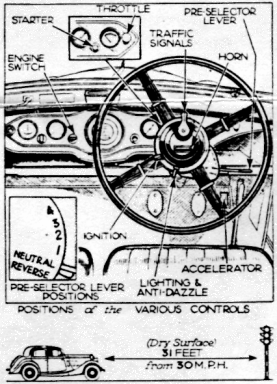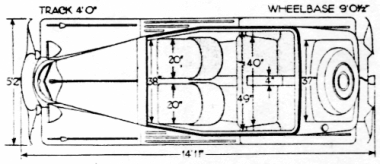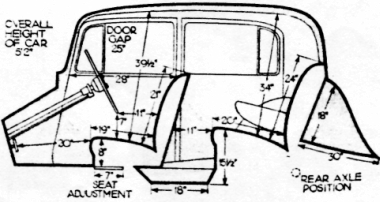 |
||
|---|---|---|
THERE is always support for a car which is offered at a price above the average in its class by engine size, and which in return provides those extra touches of refinement in equipment, comfort, and probably in appearance as well that are regarded by many owners as being desirable and worth paying more money to obtain. The Crossley Ten is this kind of car. When this model was introduced, some three years ago, it was not at a price intended to make it directly competitive with the ordinary car of similar engine size, but to give it that extra appeal to the discriminating motorist which is possible when more than the bare minimum of production expenses is permissible
The merits of this car as an individual type of 10 h.p. vehicle are still more strongly marked in the latest Regis series. This has a four-cylinder engine of the same well-tried type as used hitherto. But embodies important changes in the chassis and carries an entirely new style of four-door sports saloon body, very attractive in appearance as well as in interior comfort. There is also a car similar outwardly, but with a 1 ½-litre six-cylinder engine, as an alternative, at £365. Among the modifications made for 1935 are that the frame has been lowered appreciably and a centrifugally operated automatic clutch is used in conjunction with a pre-selector gear box. Apart from the comfort and the pleasing general style of the body, tow items stand out in contributing materially to a road performance which is both useful and satisfying. These are the preselector gear box, with its certain easy changes demanding no skill on the part of the driver for good results, and the very willing way in which the engine will rev and pull without creating an impression of fuss. Revs on the lower gears may not be a method employed by the majority of drivers to increase performance, but when the change to any ration is as simple as it is with a preselector gearbox, and when the engine performs readily and smoothly, as does that of this Crossley, it becomes pleasant to make use of capabilities in this direction. One can tell by the sound more than by the feel that it is a four-cylinder. Emphasis laid upon this aspect of the car’s behaviour does not mean that for ordinary running around on top gear the Crossley is at a disadvantage. It pulls very well on its top gear, and the present car is not as sensitive to the ignition control in accelerating from the lower speeds as was the case with earlier models. Because speeds between 40 and 50 m.p.h. are readily attained and can be kept up if required, and because too, the car is steady and rides well, controls accurately, and has powerful brakes, it is one that is able to cover the miles in a very satisfactory fashion as opposed to mere transport. Conditions for the test at Brooklands were bad, there being a very strong wind, which whilst helping of course, in one direction, pulled down the performance seriously when running into it for timed tests in the opposite direction. None the less, creditable performance figures were recorded. The highest speedometer reading during the best timed run was 68, and an unusually big variation between the mean maximum speed and the best figure recorded is accountable to the wind. The instrument showed an optimistic error of approximately 1.6 m.p.h at a reading of 50, and 1.5 at 30 and read very reasonable accurately throughout its range.
The speedometer of another similar car tat was driven read slow by 1 m.p.h at 30, and was less than 1 m.p.h. fast at a reading of 50 : the Crossley Ten deserves credit for this conservatism. Incidentally, there are calibrations on the inner face of the speedometer dial showing engine revs against road speeds on top and third gears. According to these markings 50m.p.h. on third gear, a speed attainable on that ratio, is equivalent to 5,000 r.p.m. | An advantage of the centrifugal clutch is that the car can be brought to rest with a gear engaged and without the usual necessity with this form of gear box for neutral to be preslected and the gear changing pedal depressed, or for the pedal to be held down to give a temporary neutral. Also, gear noise is eliminated when the engine is idling ant the car is stationary. In traffic the driver may brake to a standstill, at his leisure preselect and engage first gear and leave the engine ticking over gently, in which conditions the centrifugal clutch automatically disconnects the drive from the engine to the gearbox. Then when the throttle is opened, at a set engine speed the clutch engages itself, the drive is taken up, and the car moves off smoothly and gently. It is actually possible to restart from rest on top or third gear in this manner, though to do so may hardly be advisable as a general practise. Another interesting point is that without assistance from the brakes the car can be held stationary on a gradient, and will restart as soon as the throttle is opened sufficiently to take the load. This was tried, as a test on a gradient as severe as a genuine 1 in 4. The steering is fairly low geared and light, but not spongy, whilst the brakes, of servo-shoe pattern give very decisive stopping with fair pressure, ordinary slowing with light pressure on the pedal, and they are progressive and smooth in their behaviour. The springing is sufficiently supple to afford very comfortable riding, but this car is particularly steady, so that curves and even fairly sharp turns can be taken fast without roll; it is a safe-feeling vehicle at all speeds within its range. A well-placed and effective hand-brake lever is provided on the off side of the driving compartment, and getting in or out is equally easy by either door. The driving position, with a nicely shaped separate seat and pneumatic upholstery, is very comfortable, and vision is very reasonable good, though the near-side wing cannot be seen : for some front passengers the lower edge of the windscreen is a little high in relation to eye level. Leg room is ample, there is plenty of width, and the interior is excellently finished and equipped, use being made of rails and cappings in polished woodwork. A special type of window is employed in the doors, a triangular section being pivoted so that it can be hinged outwards for extraction purposes, whilst the main section of the glass rises and falls by a balanced mechanism without the usual winding handles.
There is a sliding roof, the rear seat has a centre folding arm-rest, a most useful full-width shelf is provided beneath the scuttle, in addition to which there are door pockets. All the lights as well as the anti-dazzle are controlled from the steering wheel, and self-returning flush-fitting traffic signals are operated from the centre of the steering wheel, which incidentally is spring-spoked. Three ash trays are provided, neat door locks and a twin-blade electric screenwiper, as well as twin horns. A luggage locker of really useful capacity is formed in the tail, and access to it is by a lid at the rear, on which the spare wheel is carried, with its type neatly enclosed in a metal cover. Ace wheel discs are fitted as standard. The engine looks efficient as is well arranged as regards accessibility of the auxiliaries. It has a very conveniently placed oil filler and dipstick; the fuses for the electrical system are handily situated. The tools are carried under the bonnet in lockers of such a size to make it easy to stow them away after use, there being no need to force them into a restricted space as is sometimes necessary. The radiator filler camp is placed beneath the bonnet, and the use of a large capacity header tank is noticeable point. Actually, the radiator block, which, of course, is vertical, is mounted an appreciable distance ahead of the engine itself, with a clear space between the two; the appreciable rearward slant apparent in the from appearance of the car is imparted by the angle of the radiator shell, in the front of which is a wire stone guard. Because of the arrangement the bonnet is a good deal longer than is actually called for by the size of the engine unit, and a marked gain in appearance is thus achieved. Also, as a practical feature, there is plenty of space around the engine, which is always a good point. A small car of quality, pleasing to drive, which seems to make friends at first sight for itself by an undeniably attractive appearance. Its whole “feel” and behaviour on the road suggest a car distinctly above the 10 h.p. type in impressiveness. As regards these and other points, the Regis Ten is unquestionably a gain over the previous models | |
 |
||


